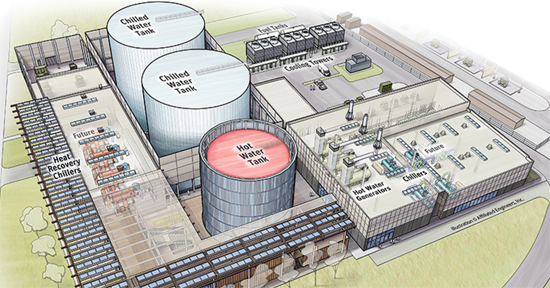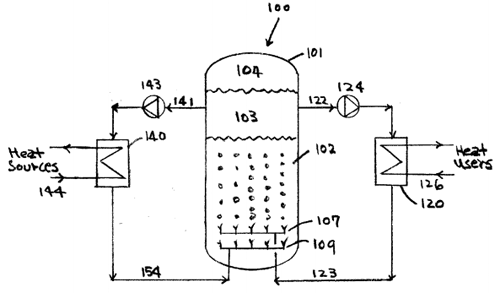 The Phase Change Matters e-mail newsletter is a weekly summary of the latest news and research on phase change materials and thermal energy storage. To subscribe, visit www.puretemp.com/subscribe. For more frequent updates, follow @puretemp on Twitter or visit the Phase Change Matters blog, www.puretemp.com/pcmatters.
The Phase Change Matters e-mail newsletter is a weekly summary of the latest news and research on phase change materials and thermal energy storage. To subscribe, visit www.puretemp.com/subscribe. For more frequent updates, follow @puretemp on Twitter or visit the Phase Change Matters blog, www.puretemp.com/pcmatters.
THERMAL ENERGY STORAGE

Stanford heating/cooling system wins top honors in engineering competition
Stanford University‘s new $485 million heating and cooling system has won the Editors’ Choice Award in Engineering News-Record‘s annual Best of the Best competition.
The Stanford Energy System Innovations project, completed in April 2015, has cut campus energy use by 50 percent. Three heat-recovery chillers in the new central energy facility (CEF) strip waste heat from 155 campus buildings via a chilled-water loop and use it to preheat a separate hot-water loop that distributes heat to the same buildings.
ENR describes the system in detail:
“The system captures 57% of building waste heat, reusing it to meet 93% of campus heating needs. For most of the year, the system precludes the need for cooling towers to discharge excess heat, which reduces water consumption on campus by 15%.
“Each heat-recovery chiller (HRC) provides a 2,500-ton cooling capacity for chilled water and simultaneously can produce 40 million BTUs of heat per hour. The HRCs send out chilled water to the campus at 42°F, which returns at 56°F to 60°F. The heat removed from the chilled water as it is cooled back down to 42°F reheats spent hot water (which returns to the CEF from campus at 130°F) back up to 160°F to 170°F to supply heating. …
“The CEF’s thermal storage system contains two 5-million-gallon tanks to store cold water and a 2.3-million-gallon tank for hot water. The tanks double as reservoirs for power, allowing flexibility to operate the heat-recovery chillers and other equipment during times of lower energy pricing or when outside air temperatures are optimal. For example, when it’s hot during the day, excess heat can be converted and stored as hot water, instead of being rejected out of evaporative cooling towers, and then used during the cooler nighttime hours.”
CONFERENCES
Agenda set for Energy Storage Europe conference March 15-17
Next week’s Energy Storage Europe conference in Düsseldorf, Germany, includes a number of sessions on thermal energy storage:
• “Integrated Thermal and Electric Storage at the District Scale,” James Bererton of Integral Group
• “Potentials for Thermal Storage Solutions,” Glen Dimplex
• “Spatial Distribution and Operator-Dependent Management of Thermal and Electrical Energy Storage Systems in Residential Areas,” Andreas Bachmaier, Fraunhofer Institute for Solar Energy Systems
• “Operational Results of a Combined Thermal Energy Storage with Electricity Generation System,” Günter Schneider, STORASOL GmbH
• “Top-down and Bottom-up Analysis of the Economics of Thermal Energy Storage,” Christoph Rathgeber, ZAE Bayern
• “Characterization and Enhancement of Phase Change Slurries,” Sophia Niedermaier, Fraunhofer Institute for Solar Energy Systems
• “Use of an undercooled phase-change material heat storage system for seasonal use,” Dr. Hermann Schranzhofer, Institute for Heating Technology, Graz University of Technology
PATENT APPLICATIONS

Latent heat thermal energy storage system bubbling tank system
U.S. patent application 20160061534 (inventor Peter B. Choi, St. Davids, Pa.):
“For a latent thermal energy storage (LTES) system comprising phase change material (PCM) slurry, it is problematic to recover thermal energy by crystallizing out solid components from slurry mixtures. It is because the solidifying components form a solid layer of low thermal conductivity on the heat transfer surfaces making heat transfer inefficient. This invention allows an effective thermal energy recovery readily achievable by using gaseous or liquid bubbles of immiscible heat transfer fluid (HTF) in close contact with the phase change material (PCM) slurry mixtures [102]. The circulating immiscible HTF, free of solidifying components, is used for releasing thermal energy through cold heat transfer surfaces to the heat users.”
Fecal incontinence device with phase change material
U.S. patent application 20160067027 (Assignee Renew Medical Inc., Menlo Park, Calif.):
“A device for treating fecal incontinence in a subject is provided. The device includes a plug configured for positioning mostly within an anal canal of the subject. … A phase change material can also be used in stem portion and optionally cap portion; the material can be stiff under room temperature and soft at body temperature. Plug can be filled with such a material and deformed while molten (e.g. by stretching the plug from its ends) to as to form a more deliverable structure with reduced cap portion diameter when the material sets. Once in the body, the material melts and plug assumes its natural configuration providing the anchoring and sealing necessary for treating fecal incontinence.”
IN BRIEF
• TemperPack, maker of jute-insulated packaging for perishable foods, is one of nine finalists for CommonBond‘s annual Social Impact Award, competing for a chance to win $10,000. TemperPack’s plastic-film cooling packs contain a solution of 95 percent water and 5 percent polyglycol.
• Online mattress startup Zen Bedding is offering its first product: a sub-$1,000 “premium” foam mattress that combines the thermo-regulation of phase change material with a cool gel memory foam.
• The Regulatory Assistance Project has taken a fresh look at how to close the projected gap between the total load a utility serves and what that load looks like after a significant amount of wind and solar energy is added to the system. Greentech Media notes that RAP gives one element — water — far more emphasis: “For the first time, managing water and wastewater pumping loads has been added as a strategy. Water heating and ice energy also have more prominent roles.”
• Reporting on ARPA-E‘s annual innovation summit, Utility Dive says “it appears the stage is set for clean energy technology to benefit from a new wave of investment in the United States as investors take advantage of increased market certainty and public policy supportive of low-carbon energy solutions.”
• Researchers at RWTH Aachen University are simulating the complex behavior of paraffin-water slurries in hydraulic networks. Possible uses include underfloor heating, cooling ceiling panels and district heating networks.
• University of Kentucky researchers are working on a new material similar to graphene. The new material, also just one atom thick, is a theoretical mix of silicon, nitrogen and boron.
• Ice Energy and Riverside Public Utilities have won an award that recognizes public-private partnerships that create jobs and drive economic growth. RPU is using Ice Energy’s Ice Bear thermal energy storage units to save energy and reduce emissions. Ice Energy says the partnership has created about 12 full-time jobs in Riverside, Calif.
• Transparency Market Research projects that the global market for ceiling tiles will top $43 billion by 2023.
• The Crescent Dunes Solar Energy Project, the world’s largest CSP plant with integrated molten salt energy storage, uses Delta Group‘s solar tracking system to synchronize more than 10,000 billboard-size heliostats. The LEED Points blog explains how it works.
• GTM Research reports that the U.S. energy storage market grew by 243 percent last year and is on pace to reach 1.7 gigawatts by 2020.
RESEARCH ROUNDUP
For our full list of recent academic research, see puretemp.com/academic. Here are highlights from the past week:
From Applied Thermal Engineering:• An experimental and numerical investigation of constrained melting heat transfer of a phase change material in a circumferentially finned spherical capsule for thermal energy storage
• Phase change materials based on polyethylene glycol supported by graphene-based mesoporous silica sheets
• Experimental study of a phase change thermal energy storage with copper foam
From Energy and Buildings:
• Physical-chemical properties evolution and thermal properties reliability of a paraffin wax under solar radiation exposure in a real-scale PCM window system
• Numerical Simulation of Thermal Mass Enhanced Envelopes for Office Buildings in Subtropical Climate Zones
From Thermochimica Acta:
• Solid liquid phase diagrams of binary fatty acid mixtures − palmitic/stearic with oleic/linoleic/linolenic acid mixture
From International Journal of Refrigeration:
• Phase change material based cold thermal energy storage: materials, techniques and applications – a review
From Energy:
• An investigation into the use of the heat pipe technology in thermal energy storage heat exchangers
From Applied Energy:
• Macro-encapsulation of metallic phase change material using cylindrical-type ceramic containers for high-temperature thermal energy storage
From Construction and Building Materials:
• Mechanical and thermal characterization of concrete with incorporation of microencapsulated PCM for applications in thermally activated slabs
From Sustainable Cities and Society:
• Simulating the Inter-Building Effect on Energy Consumption from Embedding Phase Change Materials in Building Envelopes
NETWORKING
Connect with PCM experts and industry leaders on LinkedIn
More than 600 of your peers have joined a new LinkedIn group devoted to the discussion of phase change material and thermal energy storage. The Phase Change Matters group is an interactive complement to the award-winning blog and newsletter of the same name.
You are invited to join the group and connect with PCM and TES experts from around the world. New members include María Alguacil Cubero, deputy supervisor at Abengoa Solar, Israel; Phil Horton, managing director at Dulas Ltd., United Kingdom; Alizee Navarro, engineer trainee at Nobatek, France; and Duje Perić, engineering manager at Enatel, Croatia.
YOUR TURN
Got a question about PCMs or TES? Ask our experts
Two Entropy Solutions advisors, Dr. Mohammed Farid of the University of Auckland and Lucas B. Hyman of Goss Engineering, are ready to answer your questions about phase change material and thermal energy storage. We’ll select the best questions sent to bwelter@puretemp.com and post the answers here each Friday.